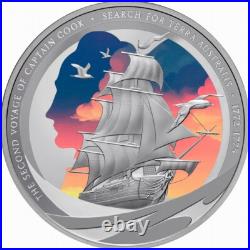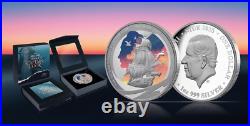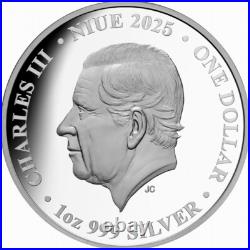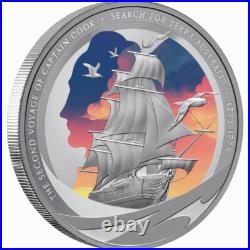
22nd July
2025











Captain James Cook-The Search for Terra Australis. Mythical in its lure, the fabled Great Southern Continent that Europeans believed in (and searched for) for centuries-this is the land that the British explorer extraordinaire Captain James Cook went in search of in 1775. The 250th anniversary of Cook’s Second Voyage of Exploration, as well as his flagship. Are commemorated on this superb design. Sojourns south under full sail, guided by a soaring albatross, with the colors of the setting sun behind. On this stunning proof finish silver dollar, a tactile sense of adventure has been captured in one full troy ounce of pure silver. Cutting edge digital minting techniques inspire the sense of wonder and awe that Cook and his crew must have felt as they sailed the unknown southern seas for the first time. Presented in a stylish case with a see-through lid, complete with an individually numbered certificate of authenticity. With the mintage restricted to a mere 750 coins worldwide, seize the day and make this numismatic treasure yours. Explorer Extraordinaire, Captain James Cook. The English navigator and seaman James Cook, possibly the greatest explorer of the 18th century and one of the greatest in human history, is known for his voyages of discovery throughout the Pacific Ocean. Among his many achievements, in 1770 Cook sighted the southeast coast of Australia, carefully charting and exploring the coast northward and naming it New South Wales. James Cook was born the son of a Scottish laborer in Yorkshire England in 1728. Cook was promoted through the Royal Navy. He rose to prominence during the war in Canada, in part due to his navigational skills and meticulous charting. His navigational talents were brought to the attention of the Royal Society and the Admiralty, after which he was promoted with the command of the bark. He sailed from Plymouth in August 1768 with a complement of ninety-four, including the noted naturalist and botanist Joseph Banks. Cook’s mission was to scrutinize the transit of Venus, but he also had confidential orders to map the fabled “Great Southern Land”. Cook’s place in the history of the Southern Hemisphere cannot be underestimated. On his first voyage alone, he charted thousands of miles of Australia’s coastline with astonishing accuracy. He is remembered as a courageous individual and one of the foremost navigators of his age. Please see the presentation lower on this page for a brief biography of Captain James Cook. With a tiny mintage of just 750, this silver proof is certain to go fast at our below issue, wholesale-direct price! Cook’s Legendary Antarctic Voyage. At about a ¼ past 11 o’clock we cross’d the Antarctic Circle… Captain James Cook, 17 January 1773 On January 17, 1773, Captain James Cook and his crew aboard his flagship. Made the first recorded crossing of the Antarctic circle, thus becoming the first Europeans to lay eyes on the unspoiled wonders of that pristine icy wilderness. Cook came within about 75 miles (120 km) of the Antarctic coast before retreating in the face of field ice. In 1775, Cook predicted the existence of a polar continent south of Australia, calling it “probable, ” and in another copy of his journal he wrote: “[I] firmly believe it and it’s more than probable that we have seen a part of it”. Captain James Cook can rightfully be considered the first in a long line of Antarctic explorers, including Amundsen, Byrd, Hillary, Mawson, Scott, and Shackleton. Captain James Cook was a British explorer, cartographer and naval officer famous for the three voyages of discovery he made between 1768 and 1779 to the Pacific Ocean, and to New Zealand and Australia in particular. Prior to these, he made detailed maps of the coast of Newfoundland. During his three voyages to the Pacific he made the first recorded European contact with eastern Australia at Botany Bay, paving the way for British settlement. He discovered the Hawaiian Islands (which he named the Sandwich Islands), as well as made the first recorded circumnavigation of New Zealand. Cook was also the first person in recorded history to sail into Antarctic waters, 250 years ago in 1773, an achievement this coin commemorates. The Antarctic circle is the most southerly of the five major circles of latitude. The region south of this circle is known as the Antarctic. During his Pacific voyages, Cook sailed tens of thousands of miles across largely uncharted areas of the globe. He surveyed and named features, and recorded islands and coastlines on European maps for the first time. He displayed the rare combination of seamanship, superior surveying and cartographic skills, physical courage, and an ability to lead men in adverse conditions that made him one of the great explorers in history. Cook died at the relatively young age of 50, but he left a legacy of scientific and geographical knowledge that influenced his successors well into the 20th century. Numerous memorials worldwide have been dedicated to him. Captain James Cook’s flagship. Advances through the South Pacific under full sail, while Cook himself remains a steadfast presence in profile portrait facing left. Meticulously rendered in glorious digital color and superbly detailed engraving. His Majesty, King Charles III, in profile effigy facing left. This portrait was executed by the engraver Jody Clark. The legend CHARLES III, the date of issue and denomination also appear, while the legend 1 OZ 999 SILVER guarantees the weight and purity. The coin is encapsulated inside a luxurious clamshell-style presentation case, lined with black velvet and satin, and protected by a full color outer cardboard box. An individually-numbered certificate of authenticity is included. The image of the back side of the certificate is a mint-supplied image intended for general reference only. The serial number in the image is NOT indicative of the serial number you will receive! Proof with Digital Color. 999 Fine (Pure) Silver. Captain James Cook-A Brief Biography. Born in the village of Marston, Yorkshire, England in 1728, James Cook rose from humble beginnings to become one of the great of Englishmen of his era. The second son of James and Grace Cook, he grew up on a farm at Great Ayton. In his teenage years, Cook was apprenticed to a shopkeeper at Staithes. An exciting, successful time in the young man’s life, Cook was ultimately offered command of the vessel. At the age of just 27-an offer he turned down due to a desire to enlist in the Royal Navy! Cook rose to prominence in the Royal Navy during the war in Canada. Although his detailed charts (including the one of Newfoundland pictured in this article) had played a major role in securing victory against the French, Cook was still largely unknown when appointed as commander of the bark. Cook’s first voyage on that sturdy, converted collier was the first of three monumental journeys of discovery that established his name as the preeminent explorer of his time. And yet, demonstrating that fate is the almost inevitable partner of greatness, the charting of the Australian east coast that occurred during his second voyage came about almost by accident. Cook’s expedition to the Pacific in 1768, made at the behest of the Royal Society, was to observe the stars on King George III Island (in Tahiti). Although the society had recommended Alexander Dalrymple as leader of this voyage to the South Seas, the Admiralty ultimately chose Cook, promoting him from master to lieutenant in the process. The stated object of the mission was for Cook to scrutinize the transit of Venus, but he also received secret orders from the admiralty to make an attempt to find the fabled Great Southern Land, and to take possession in the name of the King. He sailed from Plymouth in August 1768 with 18 months worth of provisions on board, as well as a complement of ninety-four, including Joseph Banks and his retinue. Reaching Rio de Janeiro by November, and rounding the Horn in January. Arrived in Tahiti in April, 1769. Insisting on cleanliness, and encouraging the crew to eat citrus fruits whilst at sea, Cook managed to avoid the dread disease scurvy entirely! Staying in Tahiti for three months, during which time he successfully observed the transit of Venus, Cook set sail west, discovering the Society Islands and then sighting the North Island of New Zealand. Circumnavigating New Zealand and charting the coastline, Cook discovered that it was not part of a huge continent. With just a few months worth of provisions remaining, Cook began the voyage home. Was in poor condition, so Cook sailed her along a coastline, where the seas were not as rough as on the open ocean. However, this was not just any shore; indeed, it was Australia’s eastern coastline! Aiming at Van Diemen’s Land, winds pushed. North, and on the 20th of April, 1770, land was sighted at what is now known as Point Hicks, near the current border between Victoria and new South Wales. He steered north, mapping the coast as he went, and, on the 29th of April the first landing was made at Botany Bay, now Sydney, Australia. The expedition continued along the coast until they reached the treacherous waters of the Great Barrier Reef. Struck the reef and was repaired in the spot where Cooktown now stands. From Cooktown they sailed cautiously to Cape York, where Cook and his party landed on a small island, now called Possession Island. It was here that Cook claimed the eastern coast of the island continent for Great Britain, naming his country’s new territory “New South Wales”. Reaching the Cape of Good Hope in March, Cook finally made it home to England in July, 1771 – nearly three years after setting sail from Plymouth! He was presented to King George III and granted a captain’s commission. Reinforced by his voyage of. In 1772 to prove the existence of the Great Southern Continent once and for all, Cook’s subsequent expeditions reinforced his reputation and his legend. Caught at the water’s edge as a dispute broke out between the indigenous population and his crew, Cook was stabbed in the back, dragged up the beach, and killed. He was only 50 years old. As the “Discoverer of the East Coast of Australia”, charting 2,000 miles of the continent on his first voyage, Cook’s role in Australian history cannot be overstated. He is remembered today not only as one of the foremost navigators and discoverers of the Great Age of Exploration, but also as a tremendous seaman and leader, calm, fearless, and driven. His importance to the modern psyche of Australia cannot be exaggerated. A number of the junior officers who served under Cook went on to distinctive accomplishments of their own. Cook’s sailing master, was given command of. In 1787 to sail to Tahiti and return with breadfruit. Bligh is best known for the mutiny of his crew which resulted in his being set adrift in 1789. He later became governor of New South Wales, where he was subject of another mutiny – the only successful armed takeover of an Australian colonial government! One of Cook’s midshipmen, later led a voyage of exploration to the Pacific Coast of North America from 1791 to 1794. Sailed under Cook on his third expedition, and later commanded an expedition of his own to the Pacific Coast of Canada as well as to China.
